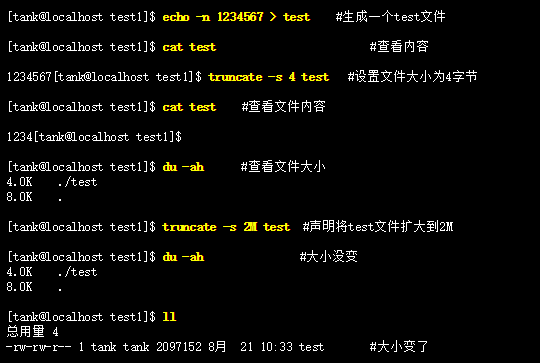1、使用重定向的方法
[root@centos7 ~]# du -h test.txt
4.0K test.txt
[root@centos7 ~]# > test.txt
[root@centos7 ~]# du -h test.txt
0 test.txt
2、使用true命令重定向清空文件
[root@centos7 ~]# du -h test.txt
4.0K test.txt
[root@centos7 ~]# true > test.txt
[root@centos7 ~]# du -h test.txt

0 test.txt
3、使用cat/cp/dd命令及/dev/null设备来清空文件
[root@centos7 ~]# du -h test.txt
4.0K test.txt
[root@centos7 ~]# cat /dev/null > test.txt
[root@centos7 ~]# du -h test.txt
test.txt
-----------------------------------------------------------
[root@centos7 ~]# echo "Hello World" > test.txt
[root@centos7 ~]# du -h test.txt
4.0K test.txt
[root@centos7 ~]# cp /dev/null test.txt
cp:是否覆盖"test.txt"? y
[root@centos7 ~]# du -h test.txt
test.txt
-----------------------------------------------------------------------
[root@centos7 ~]# echo "Hello World" > test.txt
[root@centos7 ~]# du -h test.txt
4.0K test.txt
[root@centos7 ~]# dd if=/dev/null of=test.txt
记录了0+0 的读入
记录了0+0 的写出
0字节(0 B)已复制,0.000266781 秒,0.0 kB/秒
[root@centos7 ~]# du -h test.txt
test.txt
4、使用echo命令清空文件
[root@centos7 ~]# echo "Hello World" > test.txt
[root@centos7 ~]# du -h test.txt
4.0K test.txt
[root@centos7 ~]# echo -n "" > test.txt ==>要加上"-n"参数,默认情况下会"\n",也就是回车符
[root@centos7 ~]# du -h test.txt
0 test.txt
5、使用truncate命令清空文件
[root@centos7 ~]# du -h test.txt
4.0K test.txt
[root@centos7 ~]# truncate -s 0 test.txt -s参数用来设定文件的大小,清空文件,就设定为0;
[root@centos7 ~]# du -h test.txt
0 test.txt
注:truncate命令将文件缩减或扩展至指定大小。如果指定文件不存在则创建。如果指定文件超出指定大小则超出的数据将丢失。如果指定文件小于指定大小则用0补足。

转载自:https://blog.csdn.net/lijieshare/article/details/84915846和http://linux.51yip.com/search/truncate